Table of contents
- Visiting the Dainese archive Permanent exhibition on 40 years of research
- Knee slider designed for Kenny Roberts
- Armadillo as a source of ideas
- Interview with Lino Dainese
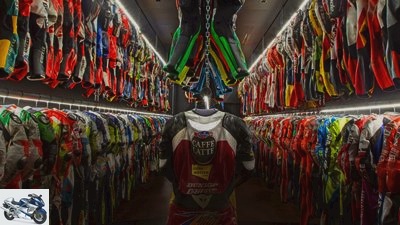
Dainese

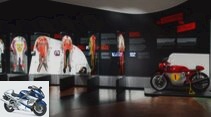
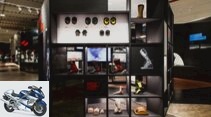
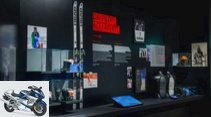
8th pictures
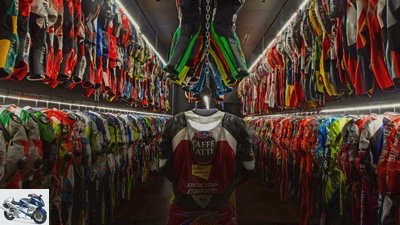
Dainese
1/8
This is how Dainese quickly became known in the early 1970s: with colorful leather suits.
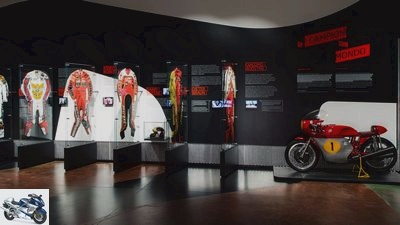
Dainese
2/8
Impressive show in the DAR: station wagons and helmets for great drivers, from Rossi to Lorenzo.
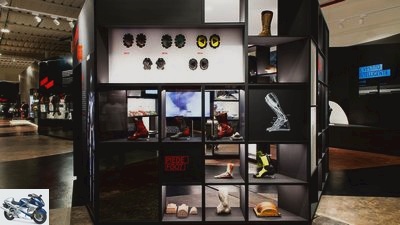
Dainese
3/8
Boots, gloves, back protectors, knee sliders and of course station wagons.
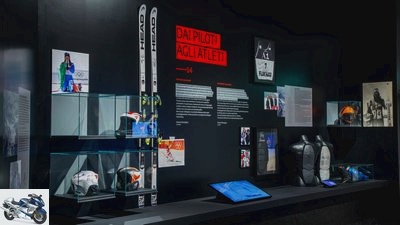
Dainese
4/8
In Dainese’s DAR, you can experience their development up close.
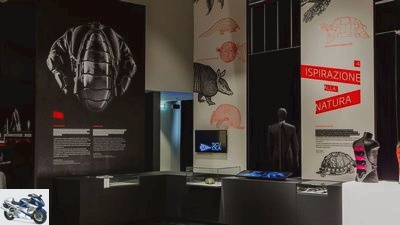
Dainese
5/8
The roots are in racing, and role models were found in the animal kingdom.
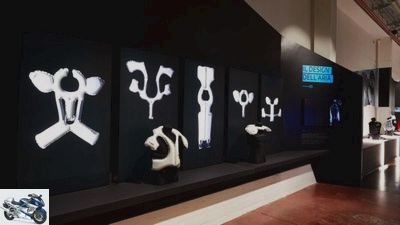
Dainese
6/8
The work on D-Air, Dainese’s airbag for motorcyclists, gave rise to a dedicated research laboratory on the subject of air.

Dainese
7/8
The DAR shows several forms of application.
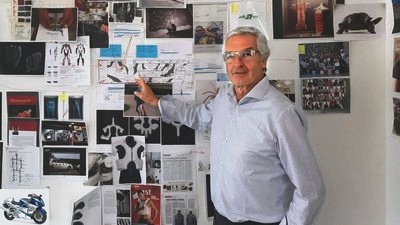
Dainese
8/8
In 2014 Lino Dainese sold 80 percent of his company and donated the proceeds. Then the research laboratory D-Air lab founded, which works closely with Dainese.
Sports & scene
Permanent exhibition Dainese-Archivio DAR
Visiting the Dainese archive
Permanent exhibition on 40 years of research
No other company experiments and researches so intensively on the subject of clothing for motorcyclists as Dainese. With the Dainese Archivio DAR, the Italians are now making exciting backgrounds and details from 40 years of research public in a permanent exhibition.
Eva Breutel
October 16, 2018
It is an immersion with all your senses in the recent history of motorcycling, especially racing. In the brand new DAR, the “Dainese Archivio”, an intelligently made multimedia show illuminates the facets of this history. Even in the “jungle of motorcycle suits” the visitor is overcome with awe: In this room hang over 1,000 racing suits of famous drivers, each one marked by at least one fall at high speed, scraped off, torn, some almost tattered. The Germans Ralf Waldmann and Toni Mang wore them, the Italians Valentino Rossi and Giacomo Agostini, the Americans Kevin Schwantz and Freddie Spencer, to name just a few names. Each brought her falls Dainese one step further in the development of highly specialized protective clothing. “Our focus was and is on racing,” says Vittorio Cafaggi from Dainese, mastermind behind the DAR. “Nowhere are there so many falls in such a short time as there, and only from them can we learn how to improve protection.” So the perfect place for a company that is serious about protective clothing.
Knee slider designed for Kenny Roberts
Company founder Lino Dainese meant it seriously from the start, as the exhibition in the DAR illustrates. On a European tour with his Vespa in 1968 in London, he marveled at the English motorcyclists on their heavy machines, many in black leather
wrapped – a completely unknown phenomenon in Italy at the time. Back at home in Veneto, the then 20-year-old made a pair of leather cross pants, which can now be seen in the DAR, including the pattern. Its functionality convinced him, and in 1972 he founded his now world-famous company. Cooperation with international racing drivers soon began. The German Dieter Braun, then 250cc world champion, was the first to start in a Dainese station wagon in 1974, soon followed by the legendary Giacomo Agostini. Dainese quickly established itself in the racing circuit, especially since the company not only focused on safety, but also on design and stood out with its bright colors.
Lino Dainese tried to implement suggestions and requests from the drivers, as the exhibition shows with numerous examples. For Agostini he used stronger leather and made the combination more comfortable with elastic inserts. The Englishman Barry Sheene had foam packed on his back to better protect his spine; this resulted in the first back protector in 1979. When Kenny Roberts, who was gifted at lean angles, entered the motorcycle world championship with his rapid driving style, Dainese quickly developed the first knee slider for him. With Toni Mang, they started to adapt the station wagon perfectly to the driver’s seating position.
Armadillo as a source of ideas
The DAR describes these exciting developments, which a short time later also went into series production for the general market. Just like the aerodynamic back hump and the airbag combination, on which Dainese researched for over ten years before it was ready for series production. It improves the protection of racing drivers so much that the FIM has made it mandatory in all classes of the motorcycle world championship since 2018.
Not only racing is the source of ideas: “We borrow a lot from nature and history, from knight armor as well as from the armadillo,” says Vittorio Cafaggi, explaining the numerous references in the DAR. The company is particularly proud that its developments not only serve motorcyclists today, but also protect many athletes in equestrian sports, downhill and ski races. The developers are not running out of ideas, as the collaboration with the Massachusetts Institute of Technology and NASA shows for spacesuits, also a topic in the DAR. “That’s exactly why we call ourselves an archive and not a museum,” says Cafaggi. “Because our story is far from over.”
Interview with Lino Dainese

Dainese
Lino Dainese (70) founded the Dainese company in 1972 after seeing the first motorcyclists in heavy leather suits in England.
In 2014, the entrepreneur sold 80 percent of his company to a Bahraini investment fund in order to secure their future with international growth; he donated the proceeds. Together with his closest colleague, Vittorio Cafaggi, he founded the D-Air lab research laboratory, which works closely with Dainese.
Lino, what are you doing research?
As always in the air (laughs), in how you can use it to protect people. The topic has fascinated me for almost 25 years. Air weighs nothing, it doesn’t take up any space and yet it can make a big difference, it can become a real protective armor. The airbag alone proves this, whether for drivers or motorcyclists.
Which projects are you specifically on??
Currently working on an airbag vest for the electricity company Enel here in Italy. We developed them for engineers and technicians who work at great heights, on power lines or on oil rigs. They are of course secured, but if you fall, your own weight or an impact often results in broken bones in the chest or shoulder area. Our vest is supposed to prevent that, it will be used in practice shortly.
It no longer has anything to do with motorcycles…
We have been researching and developing outside of the industry for a long time. I am proud of the fact that we motorcyclists are so to speak fooling others with our developments. Just take our airbag, which is also used by ski racers and which has already prevented worse things from happening in some serious falls. My first idea for the airbag had to do with ski races.
As the?
The starting point was the tragic death of Ulrike Maier, the Austrian ski racer who fell on the Kandahar in 1994 and broke her neck. That preoccupied me a lot, we at the company thought intensively about possible protection for the neck, because that is a neuralgic point. People are made to walk, not to rush down slopes at 150 km / h or to thunder down the racetrack at 300 km / h.
How did you come up with the idea of using air??
That was on a dive in the same year. I inflated the jacket and suddenly had a feeling of security. So I thought that if an inflatable vest protects the chest, the principle could also work for the neck. Although the airbag for motorcyclists is really complicated, we did a long research. At MIT in Boston they more or less laughed at me when I told them about it. However, that was at the very beginning, when I was still hoping that there might be a chemical that arises in the brain when people are scared to death and that could be used to control the airbag. I said that too, and that was probably too futuristic even for MIT (laughs).
Air is and will remain your topic. What other applications can you imagine?
Lots of things, we’re just getting started. We can use airbags in smart clothing to protect the elderly from broken bones or secure children in a kind of air capsule in the car. At the moment we are intensively researching the possibility of giving paraplegic people back at least some of their mobility, also with the help of air. But I’m not supposed to talk about that at all, don’t ask me for details! In any case, the field is wide and extremely exciting.
Related articles
-
Gori counselor technology & future Portrait: Lino Dainese Interview: Lino Dainese “I want to measure the adrenaline” Who invented it? No, for once not…
-
motorcycles Company portrait boxer Company portrait boxer Training camp From a tuning company to an independent design forge, the Boxer company has…
-
archive 19th pictures archive 1/19 The neverending MZ story: DKW RT 125. archive 2/19 MZ died on installments. Now the inheritance is still being haggled…
-
Special exhibition price for MOTORRAD subscription
Fox Sports & scene Special exhibition price for MOTORRAD subscription MOTORRAD subscription at a special price 6 issues + trade fair admission ticket…
-
IDM Superbike 1000 Janusch Prokop is a permanent Suzuki driver
Dino Eisele Sports & scene Motorsport IDM Superbike 1000 Janusch Prokop is a permanent Suzuki driver IDM Superbike 1000 Janusch Prokop is a permanent…
-
The best stories from 25 years of MOTORRAD Classic
archive Sports & scene The best stories from 25 years of MOTORRAD Classic 25 years of MOTORRAD Classic A quarter of a century MOTORRAD Classic Content of…
-
Interview with HJC company founder Wan Kee Hong
Yamaha Sports & scene Interview with HJC company founder Wan Kee Hong Interview with HJC company founder Wan Kee Hong “Koreans are extremely innovative…
-
The small ABC of motorcycle types, part 1 A ?? D.
Buell motorcycles The small ABC of motorcycle types, part 1 A ?? D. The small ABC of motorcycle types, part 1 A ?? D. ETV 1000 XB9R S4R Manufacturers…
-
Buying advice for airbag systems for motorcyclists
Alpinestars 18th pictures Photos: alpinestars 1/18 More than just (hot) air: airbags can prevent greater damage to life and limb in the event of an…
-
With four mopeds on the Grobglockner
Dentges 39 pictures Dentges, Lohse 1/39 Sounds crazy, but somehow it is too – four men, four mopeds and the Alps. Dentges, Lohse 2/39 Kick off and off…